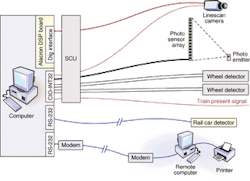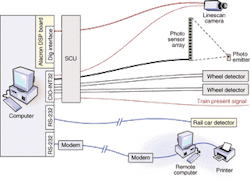Vision system automatically inspects train air hoses
After an analysis of rolling stock derailments, Conrail (Philadelphia, PA; www.conrail.com) concluded that brake failures were the dominant cause. The company reasoned that early detection and correction of brake-hose defects could prevent these related incidents, improve railroad operation safety, and minimize train delays. In addition, it determined that low-hanging and worn air hoses were early indicators of these potential problems.
To help solve these problems for Conrail, Ensco (Springfield, VA; www.ensco.com) built a wayside air-hose inspection system using off-the-shelf machine-vision components that automatically checks the hoses in slowly moving trains. If a problem hose is detected, the system sends inspection reports over telephone networks to maintenance and dispatch facilities. It is installed at the exit end of a train yard so that low-hanging or worn air hoses on every train that passes by can be inspected and rapidly repaired if necessary.
Ensco developed an inspection system that automatically inspects air hoses in slowly moving trains. Image-analysis software checks for wear patterns on the hoses near their low-hanging points. If wear is detected, the system generates an alarm.
The brake-hose inspection system monitors the hose position, measures the hose height, and captures and records hose images for further analysis using image-analysis software on a host PC. An inspection report is produced for each train; it includes a listing of the inspected hoses and their inspection results. Hoses that do not pass inspection are flagged on alarm reports that are transmitted to a remote host computer.
The rack-mounted PC-based air-hose inspection system interfaces to two dual wheel detectors from Tiefenbach (Sprockhövel, Germany; www.tiefenbach.de) using a TDA 105 interface card from SAIC (San Diego, CA; www.saic.com). These detectors determine the speed and direction of the train and the position of the train's axles. Wheel sensors, accurately placed in both directions along the train tracks, map out all the train's axles adjacent to a train-car coupling before passing a CL-3 CCD-based linescan camera from Dalsa (Waterloo, ON, Canada; www.dalsa.com) positioned below ground level.
When a train wheel is detected by one of the wheel sensors, the inspection system determines the train speed. If it is less than 15 mph, two halogen lamps mounted in a separate light compartment attached to the camera enclosure are powered to illuminate the train's brake hoses.
The air-hose inspection system uses an aboveground optical-array system to detect hose presence and measure hose height. Using a 21-element photosensor array, a low-resolution transverse silhouette of the hoses is collected at all possible train-car-coupling positions. If a hose is detected hanging below 4 in. above the railhead, an alarm message is generated.
Images from the linescan camera are delivered to the host computer using an FT200 frame grabber and daughter card from Alacron (Nashua, NH; www.alacron.com). Image-analysis software developed by Ensco runs on the host PC and checks hose wear patterns near the low hanging points. If wear is detected, the system generates an alarm. If a hose is found to be both worn and hanging too low, the system initiates a higher-priority alarm.

